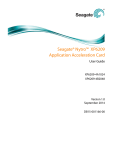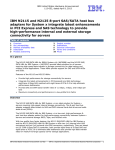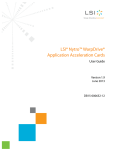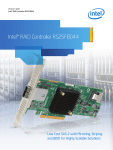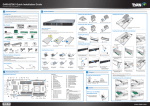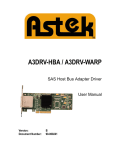Download Seagate® Nytro™ XP3000 Flash Accelerator Cards User Guide
Transcript
User Guide Seagate® Nytro™ XP6300 Flash Accelerator Cards Nytro XP6302-8B2048 Nytro XP6302-8B1536 100765563 Rev. A December 2014 Revision History Revision Date Description of Changes Rev. A, 12/8/ 2014 Initial release. Electromagnetic Compatibility Notices This device complies with Part 15 of the FCC Rules. Operation is subject to the following two conditions: 1. 2. This device may not cause harmful interference, and This device must accept any interference received, including interference that may cause undesired operation. This equipment has been tested and found to comply with the limits for a Class B digital device, pursuant to part 15 of the FCC Rules. These limits are designed to provide reasonable protection against harmful interference in a residential installation. This equipment generates, uses, and can radiate radio frequency energy and, if not installed and used in accordance with the instructions, may cause harmful interference to radio communications. However, there is no guarantee that interference will not occur in a particular installation. If this equipment does cause harmful interference to radio or television reception, which can be determined by turning the equipment off and on, the user is encouraged to try to correct the interference by one or more of the following measures: · · · · Reorient or relocate the receiving antenna. Increase the separation between the equipment and the receiver. Connect the equipment into an outlet on a circuit different from that to which the receiver is connected. Consult the dealer or an experienced radio/TV technician for help. Shielded cables for SCSI connection external to the cabinet are used in the compliance testing of this Product. Seagate is not responsible for any radio or television interference caused by unauthorized modification of this equipment or the substitution or attachment of connecting cables and equipment other than those specified by Seagate Technology LLC. The correction of interferences caused by such unauthorized modification, substitution, or attachment will be the responsibility of the user. The Nytro WarpDrive Application Acceleration Card is tested to comply with FCC standards for home or office use. This Class B digital apparatus meets all requirements of the Canadian Interference-Causing Equipment Regulations. Cet appareil numérique de la classe B respecte toutes les exigences du Règlement sur le matériel brouilleur du Canada. This is a Class B product based on the standard of the Voluntary Control Council for Interference from Information Technology Equipment (VCCI). If this is used near a radio or television receiver in a domestic environment, it may cause radio interference. Install and use the equipment according to the instruction guide. © 2014, Seagate Technology LLC All rights reserved. Publication number: 100765563, Rev. A, December 2014 Seagate, Seagate Technology and the Wave logo are registered trademarks of Seagate Technology LLC in the United States and/or other countries. Nytro, Nytro WarpDrive and SeaTools are either trademarks or registered trademarks of Seagate Technology LLC or one of its affiliated companies in the United States and/or other countries. All other trademarks or registered trademarks are the property of their respective owners. No part of this publication may be reproduced in any form without written permission of Seagate Technology LLC. Call 877-PUB-TEK1(877-782-8351) to request permission. When referring to drive capacity, one gigabyte, or GB, equals one billion bytes and one terabyte, or TB, equals one trillion bytes. Your computer’s operating system may use a different standard of measurement and report a lower capacity. In addition, some of the listed capacity is used for formatting and other functions, and thus will not be available for data storage. Actual quantities will vary based on various factors, including file size, file format, features and application software. Actual data rates may vary depending on operating environment and other factors. The export or re-export of hardware or software containing encryption may be regulated by the U.S. Department of Commerce, Bureau of Industry and Security (for more information, visit www.bis.doc.gov), and controlled for import and use outside of the U.S. Seagate reserves the right to change, without notice, product offerings or specifications. Contents Seagate Technology Support Services . . . . . . . . . . . . . . . . . . . . . . . . . . . . . . . . . . . . . . . . . . . . . . . . . . . . . . . . . . . . . . . . . . . . . . . . . . . . . . . . . . . . . . . . . . . 4 Chapter 1: Introduction . . . . . . . . . . . . . . . . . . . . . . . . . . . . . . . . . . . . . . . . . . . . . . . . . . . . . . . . . . . . . . . . . . . . . . . . . . . . . . . . . . . . . . . . . . . . . . . . . . . . . . . . . 5 1.1 Overview . . . . . . . . . . . . . . . . . . . . . . . . . . . . . . . . . . . . . . . . . . . . . . . . . . . . . . . . . . . . . . . . . . . . . . . . . . . . . . . . . . . . . . . . . . . . . . . . . . . . . . . . . . . . . . . . . . . . . . . . . . . 5 1.2 Features . . . . . . . . . . . . . . . . . . . . . . . . . . . . . . . . . . . . . . . . . . . . . . . . . . . . . . . . . . . . . . . . . . . . . . . . . . . . . . . . . . . . . . . . . . . . . . . . . . . . . . . . . . . . . . . . . . . . . . . . . . . . 5 1.3 Related Documents . . . . . . . . . . . . . . . . . . . . . . . . . . . . . . . . . . . . . . . . . . . . . . . . . . . . . . . . . . . . . . . . . . . . . . . . . . . . . . . . . . . . . . . . . . . . . . . . . . . . . . . . . . . . . . . . . 5 Chapter 2: Installation . . . . . . . . . . . . . . . . . . . . . . . . . . . . . . . . . . . . . . . . . . . . . . . . . . . . . . . . . . . . . . . . . . . . . . . . . . . . . . . . . . . . . . . . . . . . . . . . . . . . . . . . . . 6 2.1 Quick Installation Instructions . . . . . . . . . . . . . . . . . . . . . . . . . . . . . . . . . . . . . . . . . . . . . . . . . . . . . . . . . . . . . . . . . . . . . . . . . . . . . . . . . . . . . . . . . . . . . . . . . . . . . . . 6 2.2 Hardware Installation Instructions . . . . . . . . . . . . . . . . . . . . . . . . . . . . . . . . . . . . . . . . . . . . . . . . . . . . . . . . . . . . . . . . . . . . . . . . . . . . . . . . . . . . . . . . . . . . . . . . . . . 6 2.2.1 Card Retention, Shipping, and the PCIe Specification . . . . . . . . . . . . . . . . . . . . . . . . . . . . . . . . . . . . . . . . . . . . . . . . . . . . . . . . . . . . . . . . . . . . . . . . . . 6 2.2.2 Hardware Installation Steps . . . . . . . . . . . . . . . . . . . . . . . . . . . . . . . . . . . . . . . . . . . . . . . . . . . . . . . . . . . . . . . . . . . . . . . . . . . . . . . . . . . . . . . . . . . . . . . . . . 6 2.3 Software Installation Instructions . . . . . . . . . . . . . . . . . . . . . . . . . . . . . . . . . . . . . . . . . . . . . . . . . . . . . . . . . . . . . . . . . . . . . . . . . . . . . . . . . . . . . . . . . . . . . . . . . . . . 8 2.3.1 Windows Driver Installation . . . . . . . . . . . . . . . . . . . . . . . . . . . . . . . . . . . . . . . . . . . . . . . . . . . . . . . . . . . . . . . . . . . . . . . . . . . . . . . . . . . . . . . . . . . . . . . . . . 8 2.3.2 Linux Driver Installation . . . . . . . . . . . . . . . . . . . . . . . . . . . . . . . . . . . . . . . . . . . . . . . . . . . . . . . . . . . . . . . . . . . . . . . . . . . . . . . . . . . . . . . . . . . . . . . . . . . . . . 8 2.3.3 FreeBSD Driver Installation . . . . . . . . . . . . . . . . . . . . . . . . . . . . . . . . . . . . . . . . . . . . . . . . . . . . . . . . . . . . . . . . . . . . . . . . . . . . . . . . . . . . . . . . . . . . . . . . . . . 9 2.3.4 VMware ESX4.X, ESX5.X, ESXi 5.X . . . . . . . . . . . . . . . . . . . . . . . . . . . . . . . . . . . . . . . . . . . . . . . . . . . . . . . . . . . . . . . . . . . . . . . . . . . . . . . . . . . . . . . . . . . . . . 9 2.4 BIOS Boot Support Settings . . . . . . . . . . . . . . . . . . . . . . . . . . . . . . . . . . . . . . . . . . . . . . . . . . . . . . . . . . . . . . . . . . . . . . . . . . . . . . . . . . . . . . . . . . . . . . . . . . . . . . . . . 9 2.4.1 Changing the BIOS Settings . . . . . . . . . . . . . . . . . . . . . . . . . . . . . . . . . . . . . . . . . . . . . . . . . . . . . . . . . . . . . . . . . . . . . . . . . . . . . . . . . . . . . . . . . . . . . . . . . . 9 2.5 Managing the Nytro XP6300 Card . . . . . . . . . . . . . . . . . . . . . . . . . . . . . . . . . . . . . . . . . . . . . . . . . . . . . . . . . . . . . . . . . . . . . . . . . . . . . . . . . . . . . . . . . . . . . . . . . . 12 Chapter 3: Characteristics . . . . . . . . . . . . . . . . . . . . . . . . . . . . . . . . . . . . . . . . . . . . . . . . . . . . . . . . . . . . . . . . . . . . . . . . . . . . . . . . . . . . . . . . . . . . . . . . . . . . . . 13 3.1 Nytro XP6300 Card Characteristics . . . . . . . . . . . . . . . . . . . . . . . . . . . . . . . . . . . . . . . . . . . . . . . . . . . . . . . . . . . . . . . . . . . . . . . . . . . . . . . . . . . . . . . . . . . . . . . . . 3.1.1 LEDs . . . . . . . . . . . . . . . . . . . . . . . . . . . . . . . . . . . . . . . . . . . . . . . . . . . . . . . . . . . . . . . . . . . . . . . . . . . . . . . . . . . . . . . . . . . . . . . . . . . . . . . . . . . . . . . . . . . . . . . . 3.1.2 Troubleshooting the Nytro XP6300 Card . . . . . . . . . . . . . . . . . . . . . . . . . . . . . . . . . . . . . . . . . . . . . . . . . . . . . . . . . . . . . . . . . . . . . . . . . . . . . . . . . . . . . 3.1.3 Power Consumption for the Nytro XP6300 Card . . . . . . . . . . . . . . . . . . . . . . . . . . . . . . . . . . . . . . . . . . . . . . . . . . . . . . . . . . . . . . . . . . . . . . . . . . . . . . 3.1.4 Thermal Considerations . . . . . . . . . . . . . . . . . . . . . . . . . . . . . . . . . . . . . . . . . . . . . . . . . . . . . . . . . . . . . . . . . . . . . . . . . . . . . . . . . . . . . . . . . . . . . . . . . . . . . 3.1.4.1 Maximum Sensor Temperature . . . . . . . . . . . . . . . . . . . . . . . . . . . . . . . . . . . . . . . . . . . . . . . . . . . . . . . . . . . . . . . . . . . . . . . . . . . . . . . . . . . . . . . 3.2 Electromagnetic and Environmental Specifications . . . . . . . . . . . . . . . . . . . . . . . . . . . . . . . . . . . . . . . . . . . . . . . . . . . . . . . . . . . . . . . . . . . . . . . . . . . . . . . . . 3.3 Safety Characteristics . . . . . . . . . . . . . . . . . . . . . . . . . . . . . . . . . . . . . . . . . . . . . . . . . . . . . . . . . . . . . . . . . . . . . . . . . . . . . . . . . . . . . . . . . . . . . . . . . . . . . . . . . . . . . . Seagate Nytro XP6300 Flash Accelerator Cards User Guide, Rev. A 13 13 13 15 15 15 16 16 3 Seagate Technology Support Services For information regarding online support and services, visit: http://www.seagate.com/about/contact-us/technical-support/ Available services include: Presales & Technical support Global Support Services telephone numbers & business hours Authorized Service Centers For information regarding Warranty Support, visit: http://www.seagate.com/support/warranty-and-replacements/ For information regarding data recovery services, visit: http://www.seagate.com/services-software/data-recovery-services/ For Seagate OEM and Distribution partner portal, visit: http://www.seagate.com/partners For Seagate reseller portal, visit: http://www.seagate.com/partners/my-spp-dashboard/ Seagate Nytro XP6300 Flash Accelerator Cards User Guide, Rev. A 4 www.seagate.com Overview Chapter 1: Introduction 1.1 Overview This manual describes the functional, mechanical, and interface specifications for the Seagate®Nytro™ XP6300 Series Flash Accelerator Cards. The Nytro XP6300 card is a block storage device. The card presents itself to the operating system through a Fusion-MPT™ interface as a single drive that requires minimal user configuration. You can use this card for either nonpersistent (for example, cache) or persistent (for example, database files) data. The Nytro XP6300 card has a PCI Express® (PCIe®) interface that complies with the PCI Express Specification 3.0. The functionality of the Nytro XP6300 card comes from a SAS2308 I/O controller with Seagate Nytro firmware that runs on the internal processor. The following table shows the characteristics of the Nytro XP6300 card models: Table 1 Seagate Nytro XP6300 Card Characteristics Summary Device Name Model Name Raw Capacity Connector Flash Controller Nytro XP6302 XP6302-8B2048 2048 GB X8 PCIe 3.0 SF2582 Nytro XP6302 XP6302-8B1536 1536 GB X8 PCIe 3.0 SF2582 1.2 NAND Type Card Style Enterprise Half Height, Half Multi-Level Cell Length (eMLC) eMLC Half Height, Half Length Controller SAS2308 SAS2308 Features This section lists the features of the Nytro XP6300 cards. 1.3 Proven enterprise firmware stack Flash ROM for storing the BIOS and firmware Best-in-class read and write performance Average latency of less than 200 μs Low host burden – No static CPU and memory overhead Support for Windows®, Linux®, VMware®, and FreeBSD® operating systems Bootable PCIe 3.0 x 8 Half height and half length PCIe standard low-profile bracket attached to card (full-height bracket ships in the box) LEDs for drive life and drive status High reliability with block-level, page-level, and die-level failure protection Related Documents Refer to the following documents for more information on the Nytro XP6300 card and related tools. Seagate® Nytro™ WarpDrive® and Nytro XP6000 Application Acceleration Card Management Utility User Guide Seagate® Nytro™ XP6300 Application Acceleration Card Quick Installation Guide Seagate Nytro XP6300 Flash Accelerator Cards User Guide, Rev. A 5 www.seagate.com Quick Installation Instructions Chapter 2: Installation 2.1 Quick Installation Instructions You can use the quick installation instructions to install your Nytro XP6300 card, or you can see the next section if you need more detailed installation instructions. To quickly install your Nytro XP6300 card, follow these instructions. 1. Unpack the Nytro XP6300 card and inspect it for damage. 2. Turn off the server, and remove the power cord. 3. Remove the cover from the server. 4. Insert the card in an available PCIe slot that supports at least 50 W of power. 5. Secure the bracket to the system’s chassis. 6. Replace the cover and the power cord, then turn on the server. The Nytro XP6300 card hardware installation is complete. 2.2 Hardware Installation Instructions 2.2.1 Card Retention, Shipping, and the PCIe Specification The PCIe specification requires that add-in cards with a mass of greater than 350 grams must have additional card retention at the server level. Neither the connector nor the optional hockey stick feature described in the PCIe specification provides the required retention. Server OEMs and ODMs are solely responsible for choosing and qualifying their own server and rack shipping solution. Seagate does not qualify the server and rack shipping solution and is not responsible for such solution or any impact to Seagate products. Seagate will make available mechanical design collateral for its products, which may be used by server OEMs and ODMs to design retention features for their server products. Seagate information is provided AS IS only and Seagate does not certify any design retention features used by OEMs and ODMs. Seagate does not perform server and rack shock and vibration testing of OEM and ODM products. OEMs and ODMs are solely responsible for any server and rack shock and vibration testing. 2.2.2 Hardware Installation Steps 1. Unpack the Nytro XP6300 card and inspect it for damage. Unpack the card in a static-free environment and follow good antistatic grounding procedures. Remove the Nytro XP6300 card from the antistatic bag, and carefully inspect it for damage. If you notice any damage, contact Seagate, or your reseller support representative. NOTE 2. Back up your data before changing your system configuration. Prepare the computer. Turn off the server, and disconnect the power cords from the power supply. Remove the cover from the chassis. WARNING To avoid electrical shock, disconnect the server from the main power and from any networks before you install the card. Seagate Nytro XP6300 Flash Accelerator Cards User Guide, Rev. A 6 www.seagate.com Hardware Installation Instructions 3. Replace the PCI mounting bracket (system dependent). If required for your system, replace the shorter PCI mounting bracket that ships on the Nytro XP6300 card with the full-height bracket supplied. Save the two screws from the short bracket and use the screws to attach the full-height bracket. 4. Insert the Nytro XP6300 card in an available PCIe slot that provides at least 50 W of power. Locate an empty PCIe slot. Make sure the PCIe slot provides at least 50 W of power. Without sufficient power the Nytro XP6300 card may be damaged or run at less than optimal performance. Remove the blank bracket panel on the server chassis that aligns with the empty PCIe slot. Save the bracket screw, if applicable. Align the card to the PCIe slot. Press down gently, but firmly, to properly seat the card in the slot. The following figure shows how to insert the card in a PCIe slot. Figure 1 Card Installation for the Nytro XP6300 %UDFNHW 6FUHZ 3UHVV +HUH 3UHVV +HUH B 3&,H6ORW (GJHRI +RVW%RDUG 5. NOTE The shape, size, and locations of components on your Nytro XP6300 card might vary from this illustration. CAUTION For highest performance, make sure that the PCIe slot is PCIe 3.0 and make sure that it has an active width of dedicated eight lanes. CAUTION The location must meet the 300 LFM (linear feet/minute) minimum airflow requirement. Secure the bracket to the system’s chassis. Install the bracket screw, if applicable, or engage the system retention mechanism to secure the card to the system’s chassis. Seagate Nytro XP6300 Flash Accelerator Cards User Guide, Rev. A 7 www.seagate.com 6. Software Installation Instructions Replace the cover, reconnect the power cords, and power up the system. Replace the server’s cover, reconnect the power cords, and reconnect any network cables. Turn on the power. The Nytro XP6300 card hardware installation is complete. CAUTION 7. For highest performance, make sure that the PCIe slot is PCIe 3.0 and make sure that it has an active width of eight lanes or sixteen lanes. CAUTION 8. For all server types, do not ship the Nytro XP6300 card installed or mounted inside a server. Ship the card separately and install the card into the server at its final destination. This prevents potential damage during shipment. If the card is shipped installed in a server and is damaged during shipment, the applicable warranty is void. The location must meet the 300 LFM (linear feet/minute) minimum airflow requirement. Replace the cover, reconnect the power cords, and power up the system. Replace the server’s cover, reconnect the power cords, and reconnect any network cables. Turn on the power. The Nytro XP6300 card hardware installation is complete. 2.3 Software Installation Instructions 2.3.1 Windows Driver Installation The Seagate drivers for Windows Server® 2012 (x86) are available online. Download the latest Windows drivers from the Seagate website: 1. Go to the following Seagate website: http://www.seagate.com/products/solid-state-flash-storage/accelerator-cards/ 2.3.2 2. Click on Nytro XP6302 Flash Accelerator Card. 3. Click Support, and click the driver you need. 4. Download the driver files. 5. Open the Windows Driver Configuration Utility file and follow the instructions to install the driver. Linux Driver Installation Seagate provides open source drivers in the following ways: Precompiled binaries to add to an existing installation using driver update disks or RPMs for selected distributions. Fusion-MPT™ source to add or update any distribution. Download the latest Linux® drivers from the Seagate website. 1. Go to the following Seagate website: http://www.seagate.com/products/solid-state-flash-storage/accelerator-cards/ 2. Click on Nytro XP6302 Flash Accelerator Card. 3. Click Support, and click the driver you need. 4. Download the driver files and install the RPM files. Seagate Nytro XP6300 Flash Accelerator Cards User Guide, Rev. A 8 www.seagate.com 2.3.3 BIOS Boot Support Settings FreeBSD Driver Installation Download the latest FreeBSD® drivers from the Seagate website. 1. Go to the following Seagate website: http://www.seagate.com/products/solid-state-flash-storage/accelerator-cards/ 2.3.4 2. Click on Nytro XP6302 Flash Accelerator Card. 3. Click Support, and click the driver you need. 4. Download the driver files and install the drivers. VMware ESX4.X, ESX5.X, ESXi 5.X Download the latest VMware® drivers from the Seagate website. 1. Go to the following Seagate website: http://www.seagate.com/products/solid-state-flash-storage/accelerator-cards/ 2. Click on Nytro XP6302 Flash Accelerator Card.. 3. Click Support, and click the driver you need. 4. Download the driver files and unzip. Install the drivers. You have now completed the driver installation for the Nytro XP6300 card. 2.4 BIOS Boot Support Settings The Nytro BIOS permits you to change the card properties. You can specify that the card is eligible for Seagate software control or that the card is reserved for control by software that does not belong to Seagate. You can select from the following settings in the Boot Support feature of the BIOS: Enabled BIOS and OS permits the BIOS and the operating system driver to control the card. Enabled BIOS Only permits the BIOS to control the card. The operating system driver does not control the card. Some operating system drivers (such as Windows drivers) do not support this option. Enabled OS Only permits the operating system to control the card. The BIOS does not control the card with this setting. Disabled prevents the motherboard from considering the card as a boot device. Therefore you cannot boot from the card. However, you can still see the card when you use the configuration protocol, and in all other respects, the card performs as usual. You can use this option when you have multiple cards in your system and you do not plan to boot from this card. Changes to these settings display in the Status field on the main Adapter List menu. The new setting takes effect when the BIOS reloads when you reboot the system. Selecting Disabled prevents the user from booting the card, but in all other respects the card will work the same. 2.4.1 Changing the BIOS Settings To change the BIOS settings, follow these instructions: 1. At power-on, press Ctrl-C to log on to the BIOS screen. NOTE The model number, date, and firmware number for your Nytro XP6300 card will vary from the illustrations below. Seagate Nytro XP6300 Flash Accelerator Cards User Guide, Rev. A 9 www.seagate.com BIOS Boot Support Settings Figure 2 The BIOS Screen Seagate Nytro XP6300 Flash Accelerator Cards User Guide, Rev. A 10 www.seagate.com 2. BIOS Boot Support Settings Press Enter to go to Adapter Properties. Figure 3 The Adapter Properties Screen Seagate Nytro XP6300 Flash Accelerator Cards User Guide, Rev. A 11 www.seagate.com 3. Managing the Nytro XP6300 Card To toggle between the Boot Support settings, use the -/+/ Enter keys. Figure 4 The Disabled Boot Support Setting 4. 2.5 Press Esc to exit the BIOS menu. Managing the Nytro XP6300 Card You can use the following tools to manage your Nytro XP6300 card: BIOS This tool is available only during boot. Use this tool to view information about the card and to configure the boot support options. See BIOS Boot Support Settings. DDCLI This menu-driven, command line interface tool permits you to view information, view the status, and flash upgrade the firmware for the Nytro XP6300 card. Refer to the Seagate® Nytro™ WarpDrive® and Nytro XP6000 Application Acceleration Card Management Utility User Guide. Seagate Nytro XP6300 Flash Accelerator Cards User Guide, Rev. A 12 www.seagate.com Nytro XP6300 Card Characteristics Chapter 3: Characteristics This chapter presents characteristics for each Nytro XP6300 card. 3.1 Nytro XP6300 Card Characteristics The Nytro XP6300 card uses a low-profile, half-height, and half-length PCIe board. The Nytro XP6300card uses a SAS2308 controller with drive firmware that runs on its internal processor. The Nytro XP6300 card can be used for either persistent or nonpersistent data and offers high-performance with low latency and a low CPU burden. The following figure shows the Nytro XP6300 card. Figure 5 Nytro XP6300 Card 3.1.1 LEDs Two board-mounted, right-angle LEDs shine through holes in the PCI bracket: one is for drive life and one is for drive status. The LEDs are labeled on the bracket. 3.1.2 Troubleshooting the Nytro XP6300 Card The LEDs provide key status information to diagnose any problem with the Nytro XP6300 card. You can also contact Technical Support. The following figure shows the LED layout. Seagate Nytro XP6300 Flash Accelerator Cards User Guide, Rev. A 13 www.seagate.com Nytro XP6300 Card Characteristics Figure 6 Nytro XP6300 Card LED Diagram The following table shows LED Descriptions: Table 2 Status Indicators on a Running System Name Life Status Color LED Description Green On, steady – Card has sufficient life remaining for programming and erasing the Flash memory. No action required. Yellow On, steady – Card has approximately 10% or less of life remaining for programming and erasing the Flash memory. Plan for replacements. Red On, steady – Card has no program or erase cycles left. Data can be read, but writes are at risk. Back up data and copy to a new Nytro XP6300 card. Green On, steady – Normal. On, blinking – Lets the user locate a specific Nytro XP6300 card in a rack of servers. Yellow On, steady – Warning. One of the following conditions applies: Temperature warning. If this condition persists, you might damage your Nytro XP6300 card. Increase cooling for the card or shut down your system to prevent damage. Other component issues: Run the list and health commands in the ddcli utility to determine which component has an issue. Red On, blinking – Firmware fault code: Run the ddcli utility to determine which component has an issue. If no information appears, reboot the system and retry. If no information appears, contact Seagate Technology Support Services. On, steady – One of the following conditions applies: One or more SSDs failed (IT mode). At least one SSD has exceeded its temperature. Failed RAID volume (DD mode). No RAID volume is configured (DD mode). Backup power store failed. Other component issues: Run the list and health commands in the ddcli utility to determine which component has an issue. If no information appears, reboot the system and retry the utility (DD mode). Seagate Nytro XP6300 Flash Accelerator Cards User Guide, Rev. A 14 www.seagate.com Nytro XP6300 Card Characteristics If you experience a problem with your Nytro XP6300 card that you cannot resolve, report it to your FAE or, if you obtained the product from an OEM, report it to the OEM. Keep these tips in mind when reporting a problem: 3.1.3 Clearly identify and report the revision level of the Nytro XP6300 card. To view this information, use the ddcli command, Option 1. Report the part number listed on the label, and clearly identify the board revision. Describe the steps leading up to the error. Report the operating system version and the host driver version. Power Consumption for the Nytro XP6300 Card The Nytro XP6300 card receives power from the PCIe 12-V power rail. Use the following data for power consumption. Table 3 Power Consumption Idle Typical Power I/O Maximum Power I/O 21.1 W 36.2 W 37.2 W NOTE Typical power I/O was measured at 8-KB, random access, 30% write, 70% read, Queue Depth (QD)=32/SSD. Maximum power I/O was measured at 4-KB, random access, 70% write, 30% read, QD=32/SSD. 3.1.4 Thermal Considerations The board is designed to operate in an environment defined by the following parameters: Temperature range: Relative humidity range: Maximum wet bulb temperature: Minimum airflow: Relative humidity range: Operating altitude: De-rate: 5 °C to 45 °C 5% to 90% noncondensing 28 °C 300 LFM 20% to 80% non-condensing 3000 m 2 °C per 1000 m above 1000 m The board is designed for the following storage and transit environmental parameters: 3.1.4.1 Temperature range: Relative humidity range: –25 °C to 70 °C 5% to 95% non-condensing Maximum Sensor Temperature System design and cooling capacity variations can affect the actual airflow delivered to the Nytro XP6300 cards. System-level fan speeds might require adjustment to make sure that the Nytro XP6300 sensor temperature does not exceed the maximums. The maximum sensor temperature for the Nytro XP6300 cards is 76 °C. Seagate Nytro XP6300 Flash Accelerator Cards User Guide, Rev. A 15 www.seagate.com 3.2 Electromagnetic and Environmental Specifications Electromagnetic and Environmental Specifications The Nytro XP6300 card is designed to minimize electromagnetic emissions, susceptibility to radio frequency energy, and the effects of electrostatic discharge. The card carries the CE mark, C-Tick mark, Canadian Compliance Statement, KCC, HF, Taiwan BSMI, Japan VCCI, and FCC Class B, and the card is marked with the FCC Self-Certification logo. The card also meets the requirements of CISPR Class B. 3.3 Safety Characteristics All Seagate PCIe boards meet or exceed the requirements of UL flammability rating 94V-0. Each bare board is marked with the supplier’s name or trademark, type, and UL flammability rating. Because these boards are installed in a PCIe bus slot, all voltages are below the SELV 42.4-V limit. Seagate Nytro XP6300 Flash Accelerator Cards User Guide, Rev. A 16 Seagate Technology LLC AMERICAS Seagate Technology LLC 10200 South De Anza Boulevard, Cupertino, California 95014, United States, 408-658-1000 ASIA/PACIFIC Seagate Singapore International Headquarters Pte. Ltd. 7000 Ang Mo Kio Avenue 5, Singapore 569877, 65-6485-3888 EUROPE, MIDDLE EAST AND AFRICA Seagate Technology SAS 16-18 rue du Dôme, 92100 Boulogne-Billancourt, France, 33 1-4186 10 00 Publication Number: 100765563, Rev. A December 2014

















